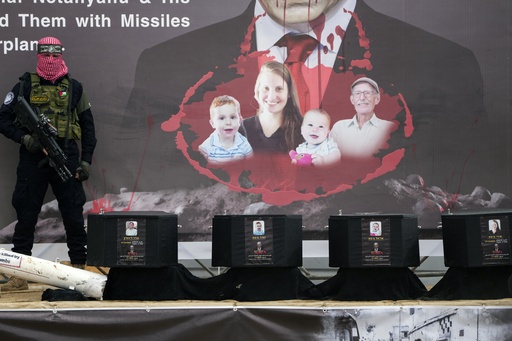
JERUSALEM — The tragic story of Ariel and Kfir Bibas, some of the youngest hostages taken during Hamas’ gruesome assault on October 7, 2023, has become a poignant representation of the suffering endured by many Israelis. The news of their presumed bodies being returned on Thursday shattered any lingering hopes for their survival and dealt a significant emotional blow to a nation still grappling with the aftermath of the attack.
The Bibas brothers, aged just 4 years and 9 months at the time of their abduction, captured the hearts and minds of the Israeli public. The return of their remains, alongside a body identified as their mother, Shiri Bibas, brings a devastating sense of closure to the ongoing tragedy but also raises fresh anger towards the government’s inability to secure the release of around 250 hostages still believed to be held in Gaza. Such developments may intensify calls for Prime Minister Benjamin Netanyahu to consider a ceasefire extension.
The Bibas family was taken from Kibbutz Nir Oz, and a disturbing video depicting the abduction was widely circulated globally, showing Shiri desperately wrapping her two boys in a blanket while being taken away by armed assailants. Yarden Bibas, the father, was also abducted but was released on February 1 as part of a ceasefire agreement between Israel and Hamas, which has so far resulted in the release of 33 hostages in exchange for nearly 2,000 Palestinians detained by Israel. Israel has reported that eight of those released were confirmed dead.
Since being freed, Yarden has continuously sought any information regarding the fate of his family, who remained missing for much of the duration of the conflict. Although Hamas released a video of him while in captivity as evidence of his survival, no communication was ever made regarding Shiri or their children. Hamas claimed they were killed in an Israeli airstrike during the early days of the conflict, a report that Israel vaguely acknowledged, expressing “grave concerns” for their wellbeing instead of confirming their death.
The formal identification process for the returned bodies is expected to take up to 48 hours. The Bibas brothers have become symbols of the national outcry demanding the safety and return of hostages. Concern for their fate escalated during a November ceasefire when a number of women and children were freed, and it grew intensified following the release of living female hostages in recent weeks.
At a mere 9 months old, Kfir was one of about 30 children snatched on October 7. His cherubic image spread throughout Israel, prompting leaders to invoke his plight in speeches both domestically and internationally. The Bibas extended family has been visible in anti-government protests advocating for the return of the “ginger babies,” encouraging a movement represented by the color orange. They also commemorated Kfir’s first birthday with the release of orange balloons, as they sought support from global leaders.
Household photographs of the Bibas family circulated widely on television and social media created a significant emotional connection among the Israeli population. They learned of Ariel’s fondness for Batman, with pictures showing the entire family enjoyed dressing as the superhero during happier times. The Hostages Families Forum has reiterated that many other hostages remain in Gaza, urging the government to act swiftly and ensure their survival.
The ambiguity surrounding Shiri Bibas and her children led to widespread uncertainty, even among close family members. Shiri’s sister, Dana Silberman-Sitton, expressed her belief that neither her sister nor the children were alive, having shared her decision to inform her own children in December that Shiri and the boys were presumed dead after Hamas’ assertion about their deaths due to Israeli airstrikes.
This sentiment was echoed throughout the family, with Yarden’s sister, Ofri Bibas Levy, adamantly maintaining that the children and their mother were still alive. She rallied various efforts, traveling and engaging in interviews to keep their story in public discourse. The story of the Bibas family struck a chord both in Israel and abroad, illustrating the most harrowing elements of Hamas’ attack. Ruth Pat-Horenczyk, a professor at Hebrew University specializing in trauma, explained that the heartbreaking image of Shiri attempting to protect her children has left an indelible mark on the nation’s consciousness.
“The collective pain and horror experienced by this family became a striking symbol of the event of October 7,” she reflected, emphasizing the profound impact their plight had on the nation.

